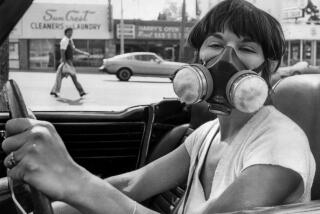VIEWPOINTS : Will ‘Smoke-Free’ Cigarettes Clear the Air? : They Mask the Fact That Smoking Kills Users and Non-Users
- Share via
You have to hand it to them: R. J. Reynolds Tobacco Co.’s introduction of a “smoke-free” cigarette last week was well-timed.
Every day brings reports of new ordinances to protect non-smokers in public places from exposure to tobacco smoke. Private industry and the federal government have stepped up the implementation of policies to protect non-smokers in the workplace. The U.S. Center for Disease Control has announced the lowest-ever percentage of smokers among American adults, and in Congress efforts to prohibit smoking in airplanes, increase cigarette excise taxes, limit tobacco advertising and promotion, and regulate tobacco products under consumer protection and health and safety laws, are gaining momentum.
Under siege, RJR Nabisco, the parent company, announces a “technological breakthrough” it hopes will be the cigarette industry’s magic bullet: a cigarette that doesn’t burn, and therefore doesn’t give off visible “secondhand” smoke and also offers to the smoker a “cleaner” smoke without the “tar” of a regular cigarette.
But is this really an answer to the major health and safety issues that are the focus of today’s heated debate about smoking? The answer is no, for the following reason: Cigarettes kill, and nothing we know about RJR’s new product gives any reason to believe that this smoke-free cigarette will be any less harmful than regular cigarettes to the smoker or to non-smokers exposed to the gases it gives off. Invisible smoke does not make safe smoke, and this new cigarette is yet another gimmick to deflect attention from what really is at issue: Cigarette smoking is the single largest preventable cause of death in our nation today, killing more than 300,000 Americans annually, and also jeopardizes the health of non-smokers exposed to tobacco fumes.
Some Compounds Reduced
Of course, RJR has been careful to avoid characterizing its new product as a safer cigarette, preferring to skirt the issue by emphasizing that the product responds “to the perceptions and desires of today’s smokers.” In fact, RJR cannot make health claims for its new product, because then it would be conceding what it cannot admit to: Smoking regular cigarettes causes disease.
According to RJR, this new cigarette delivers the same amount of nicotine (the addictive drug found in all tobacco products) and carbon monoxide (a source of the heart disease associated with cigarette smoking) as a regular “full-flavor, low-tar” cigarette. But RJR also claims that “a majority of the compounds . . . associated with the smoking and health controversy” are reduced or eliminated because the tobacco in this new cigarette is heated rather than burned. (“Smoking and health controversy” is the industry’s preferred way of addressing the fact that more Americans die every year from cigarette smoking than are killed by AIDS, cocaine, heroin, alcohol, fire, automobiles, homicide and suicide combined.)
However, regular tobacco smoke has more than 4,000 constituents, dozens of which are known toxins, carcinogens, or co-carcinogens, so the reduction or elimination of some does not necessarily alter the lethal nature of these emissions. Finally, because this new cigarette and all tobacco products are exempt from all regulation under federal health, safety and consumer protection laws, whatever additives, chemical compounds, or other enhancements have been included in this cigarette to replace the tar flavor and make it taste and feel like a “real smoke,” do not have to be reported to, studied by, or otherwise controlled for consumer safety and health by any federal regulatory agency.
Seeking Better Image
In other words, this magic bullet is also a mystery bullet, with potential risks to the consumer not yet conceived of, and, most tragically, uncontrollable through the normal regulatory process for consumer products.
Therefore, it comes as no surprise that RJR has so carefully sidestepped any direct safety or health claims for its new cigarette, while leaning heavily on the language of “the perceptions” and “perceived desires” of the public. A better image is what RJR is after with their smoke-free cigarette; a better image for smokers and non-smokers, who will hear “smoke-free” and think “safer” cigarette. But a better image is no substitute for the facts, and just because this cigarette smoke has suddenly been made invisible does not make the health concerns disappear as well.
Almost 10 years ago, a market research survey conducted for the Tobacco Institute by the Roper Organization correctly identified the most significant threat to the continued health of the tobacco industry: the non-smokers’ rights movement. And it is the non-smoker that this new cigarette is intended to subvert.
The phenomenal changes in attitudes, as well as laws, governing the propriety of smoking in public places over the past 10 years has proved the Roper Organization’s prediction about the threat posed by non-smokers correct, and has put the cigarette manufacturers on the defensive. RJR’s new smoke-free cigarette is the next move in their ongoing battle to stem the tide of public disapproval of cigarette smoking, which relegates smokers to isolated rooms where their smoke harms only themselves.
Undoubtedly, RJR’s theory is that because the smoke from this new cigarette is invisible, this will mean that smokers will be able to use their product in environments shared by non-smokers without offending anyone’s sensibilities. But sensibilities are not the focus of non-smokers’ concerns, and the hazards posed by the chemical soup that comprises tobacco smoke, visible or invisible, remain.
In conclusion, then, R. J. Reynolds Tobacco is developing a product that addresses an image problem. But no progress has been made in what is really at issue: Cigarettes will continue to kill both smokers and non-smokers. There can be no such thing as a “safe” cigarette.
More to Read
Sign up for Essential California
The most important California stories and recommendations in your inbox every morning.
You may occasionally receive promotional content from the Los Angeles Times.










